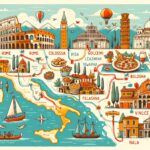Are you in search of the perfect travel itinerary for Greece and Italy? Look no further. In this article, we will explore the enchanting destinations of these two Mediterranean countries, providing you with a comprehensive guide to make the most out of your trip.
From the historical landmarks of Athens to the beautiful beaches of Santorini, and from the iconic landmarks of Rome to the rich Renaissance history of Florence, this travel itinerary has it all. Join us as we embark on an unforgettable journey through these captivating destinations.
Greece and Italy are renowned for their rich history, stunning landscapes, and vibrant cultures, making them top choices for travelers seeking diverse experiences. Whether you are a history buff, a foodie, or simply someone who appreciates breathtaking views, these countries have something for everyone. From ancient ruins to picturesque islands and bustling cities, there is no shortage of adventures awaiting you in Greece and Italy.
In this article, we will delve into each destination, providing tips for preparing for your trip, exploring key attractions in Athens, Santorini, Rome, Florence, and Venice, as well as savoring the distinct flavors of Greek and Italian cuisine. So sit back, relax and let us take you on a journey through the allure of Greece and Italy.
Preparing for Your Trip
When preparing for a travel itinerary for Greece and Italy, it’s important to pack wisely and plan ahead for the diverse experiences that these two countries have to offer. Here are some tips and tricks to help you get ready for your adventure:
- Research the weather: Before you start packing, make sure to check the weather forecast for both Greece and Italy during the time of your visit. This will help you determine what type of clothing to bring, whether it be light summer attire for the sunny shores of Santorini or warmer layers for exploring the historical sites in Rome.
- Pack versatile clothing: Since your travel itinerary for Greece and Italy includes a mix of beach destinations and city sightseeing, it’s essential to pack versatile clothing that can easily transition from day to night. Consider bringing items that can be mixed and matched to create different outfits while saving space in your luggage.
- Don’t forget comfortable shoes: With all the walking involved in exploring ancient ruins, charming villages, and bustling cities, it’s crucial to pack comfortable shoes. Opt for supportive footwear that can withstand long hours of walking without sacrificing style.
By following these packing tips and tricks, you’ll be well-prepared for your travel itinerary for Greece and Italy, allowing you to fully enjoy every moment of your Mediterranean adventure.
Athens, Greece
Discovering Ancient Ruins
When planning your travel itinerary for Greece and Italy, Athens is often the first stop on the list. As the capital of Greece, this city is a treasure trove of ancient history and culture.
A must-see destination in Athens is the Acropolis, a UNESCO World Heritage site that houses several ancient buildings, including the famous Parthenon. Here, visitors can marvel at the architectural wonders of the past and gain insight into the civilization that laid the foundation for Western culture.
Immersing in Greek Culture
In addition to exploring historical landmarks, Athens offers plenty of opportunities for visitors to immerse themselves in Greek culture. The Plaka neighborhood, located at the foot of the Acropolis, is known for its charming streets lined with colorful buildings, traditional tavernas, and local artisan shops. This area provides a glimpse into everyday life in Athens and allows travelers to savor authentic Greek cuisine while enjoying live music performances.
Navigating Modern Athens
While Athens is rich in history, it also boasts a vibrant modern scene. Visitors can take a stroll through Syntagma Square, where they can witness the changing of the guard at the Hellenic Parliament building.
Exploring the bustling neighborhoods of Kolonaki and Psiri also offers insight into contemporary Athenian life, with trendy cafes, art galleries, and boutique stores to be discovered. Ultimately, Athens provides a unique blend of ancient wonders and modern delights that make it an essential part of any travel itinerary for Greece and Italy.
Santorini, Greece
When visiting Santorini, one cannot miss out on the opportunity to visit the picturesque village of Oia. This village is famous for its breathtaking sunsets, stunning cliffside views, and narrow winding streets lined with shops and cafes. Travelers can wander through the labyrinth of white buildings adorned with blue domes and capture postcard-perfect moments at every turn.
In addition to exploring the villages, visitors should take advantage of Santorini’s beautiful beaches. Whether it’s the red sands of Red Beach or the black sands of Perissa Beach, each beach offers its own unique charm and beauty. Travelers can soak up the Mediterranean sun, swim in the refreshing waters, or enjoy water activities such as snorkeling or paddleboarding. No trip to Santorini would be complete without a relaxing day by the sea.
To make the most of your time in Santorini, consider embarking on a sailing excursion around the island. Whether it’s a catamaran cruise or a private yacht charter, exploring Santorini from the water provides a different perspective and allows travelers to discover hidden coves and pristine swimming spots.
Additionally, don’t forget to indulge in authentic Greek cuisine at local tavernas and restaurants, where you can savor delicious seafood dishes and traditional Greek specialties while taking in panoramic views of the island’s coastline.
- Explore the picturesque village of Oia
- Visit iconic beaches such as Red Beach and Perissa Beach
- Embark on a sailing excursion around the island
- Indulge in authentic Greek cuisine at local tavernas
Rome, Italy
Rome, often referred to as the Eternal City, is a destination rich in history, culture, and iconic landmarks. Visitors are immediately struck by the grandeur of the Colosseum, an ancient amphitheater that once hosted gladiator combats. The Roman Forum, the political and religious center of ancient Rome, provides a glimpse into the city’s storied past. Additionally, the Pantheon, a former Roman temple that has been repurposed as a church, is a marvel of engineering and architecture.
One cannot visit Rome without taking the time to explore Vatican City, an independent city-state enclaved within Rome. Here lies St. Peter’s Basilica, one of the holiest Catholic shrines and an exemplary display of Renaissance architecture. Visitors can also tour the Vatican Museums to view precious works of art collected by various popes over centuries.
In addition to historical landmarks, Rome offers countless charming piazzas, or public squares. Piazza Navona is adorned with fountains and baroque palaces while the Spanish Steps lead to Trinità dei Monti church and offer panoramic views of the city below. Exploring Rome truly feels like stepping into a living museum with its layers of history waiting to be discovered.
| Rome Landmark | Historical Significance |
|---|---|
| The Colosseum | An ancient amphitheater where gladiator combats were held |
| Vatican City | Home to St. Peter’s Basilica and important works of art in its museums |
| Piazza Navona | A charming square featuring fountains and baroque palaces |
Florence, Italy
Exploring Florence’s Renaissance Heritage
Florence, the capital of Italy’s Tuscany region, is renowned for its rich history and artistic legacy. The city was a major player in the Renaissance movement, with famous artists like Michelangelo, Leonardo da Vinci, and Botticelli leaving their mark on its monuments and artworks. Visitors can dive into this extraordinary cultural heritage by exploring world-class museums such as the Uffizi Gallery, which houses masterpieces like Botticelli’s “The Birth of Venus” and da Vinci’s “Annunciation”.
Iconic Landmarks and Architecture
While in Florence, be sure to visit the iconic Duomo Cathedral, a breathtaking architectural marvel with its imposing dome designed by Brunelleschi. Stroll through the historic center to admire the medieval Ponte Vecchio bridge, lined with charming shops selling jewelry and art. History buffs will also appreciate a visit to Palazzo Pitti, once home to the powerful Medici family and now a museum complex displaying priceless art collections.
Experiencing Florentine Cuisine and Lifestyle
In addition to its historical sites and art treasures, Florence offers a vibrant culinary scene. Indulge in traditional Tuscan dishes at local trattorias, savoring specialties such as ribollita (a hearty vegetable soup) or bistecca alla fiorentina (Tuscan-style steak).
To unwind after a day of sightseeing, join locals for an evening passeggiata (leisurely walk) along the Arno River or relax at a sidewalk café in Piazza della Signoria. With its mix of art, history, and gastronomy, Florence truly captures the essence of Tuscany and enriches any travel itinerary for Greece and Italy.
Venice, Italy
Venice is a city unlike any other, with its intricate network of canals and distinctive Venetian culture. As you plan your travel itinerary for Greece and Italy, be sure to include Venice as a must-visit destination. The best way to explore the city is by taking a ride on a traditional gondola, allowing you to meander through the narrow waterways and absorb the enchanting atmosphere of this unique city.
One of the most iconic landmarks in Venice is St. Mark’s Square, home to the stunning St. Mark’s Basilica and the grand Doge’s Palace. Visitors can also climb up the Campanile di San Marco for breathtaking panoramic views of the city and its surrounding lagoon. As you stroll through the charming streets, don’t forget to visit the Rialto Bridge, which has been a symbol of Venice for centuries and offers picturesque views of the Grand Canal.
In addition to its beautiful architecture and scenic canals, Venice boasts a rich cultural heritage that is evident in its art galleries, museums, and artisan workshops. The city is known for its traditional glass-making industry on the island of Murano, where visitors can witness skilled artisans at work creating intricate glass creations. To truly immerse yourself in Venetian culture, take time to explore local markets selling fresh produce, seafood, and authentic Italian delicacies.
Planning for Diverse Experiences
Travel Itinerary for Greece and Italy offers not only a rich tapestry of historical landmarks and breathtaking landscapes but also a diverse culinary experience that will delight your taste buds. When planning your travel itinerary for Greece and Italy, it’s important to consider the distinct flavors of Greek and Italian cuisine. From the aromatic herbs and fresh seafood of the Mediterranean to the savory pastas and delectable gelato, each bite will be a journey in itself.
In Greece, be sure to indulge in classic dishes such as moussaka, gyros, and souvlaki. These flavorful dishes are made with local ingredients like olive oil, feta cheese, and ripe tomatoes. Make your way to a local taverna or enjoy a meal overlooking the stunning views of the Aegean Sea while savoring these traditional Greek flavors. Don’t forget to pair your meal with a glass of retsina or ouzo for an authentic dining experience.
As you make your way through Italy, prepare to feast on an array of pasta dishes, pizzas, and regional specialties. From the rich bolognese sauce in Bologna to the creamy risotto in Milan, each region offers its own unique take on Italian cuisine. And let’s not forget about the gelato. Indulge in this creamy treat as you stroll through the cobblestone streets of Rome or Florence.
Your travel itinerary for Greece and Italy would not be complete without trying some Italian wine at one of the country’s renowned vineyards or enjoying a relaxing meal at a family-owned trattoria in Tuscany. Embrace the Mediterranean way of life by relishing each dish and savoring every mouthful during your unforgettable journey through Greece and Italy.
Conclusion
As you conclude your unforgettable travel itinerary for Greece and Italy, take a moment to reflect on the sheer beauty of the Mediterranean and the lasting memories from your trip. The allure of these two iconic destinations has captivated travelers for centuries, and as you prepare to return home, you may find yourself longing to return to the stunning landscapes, rich history, and vibrant cultures that make Greece and Italy truly unique.
From the ancient city of Athens with its historical landmarks to the breathtaking island of Santorini with its beautiful beaches and charming villages, Greece offers a diverse array of experiences. Meanwhile, in Italy, you explored the Eternal City of Rome with its iconic landmarks, immersed yourself in the rich Renaissance history and art of Florence, and navigated the canals of Venice while experiencing its unique culture.
As you reflect on your journey through these enchanting destinations, it’s clear that both Greece and Italy have left an indelible mark on your heart.
Furthermore, savoring the distinct flavors of Greek and Italian cuisine undoubtedly added a memorable element to your trip. Whether indulging in traditional moussaka in Athens or enjoying a creamy gelato in Florence, the culinary experiences throughout your travel itinerary have certainly contributed to the richness of your overall adventure.
As you fondly reminisce about the delicious meals you enjoyed along the way, it’s evident that tasting the local cuisine was an integral part of fully immersing yourself in the culture of each destination.
Frequently Asked Questions
How Many Days Do You Need for Italy and Greece?
The ideal number of days for Italy and Greece would be at least 2 weeks, or more if possible. This will allow you to explore the major attractions in both countries without feeling too rushed.
What Is the Best Month to Travel to Italy and Greece?
The best month to travel to Italy and Greece is typically during the shoulder seasons of spring (April-May) and fall (September-October). During these months, the weather is pleasant, the crowds are smaller, and prices are more reasonable.
Can You Do Italy and Greece in 14 Days?
It is possible to visit both Italy and Greece in 14 days, but it will require careful planning and prioritizing of locations. You won’t be able to see everything, but with an efficient itinerary, you can still experience some of the best highlights in both countries within that timeframe.

I’m a passionate traveler, writer, and Italophile. My fascination with Italy’s history, art, and culture has led me on countless adventures across the Italian landscape. Through “I Live Italy,” I share my love for this extraordinary country and aims to inspire others to explore its boundless beauty.





